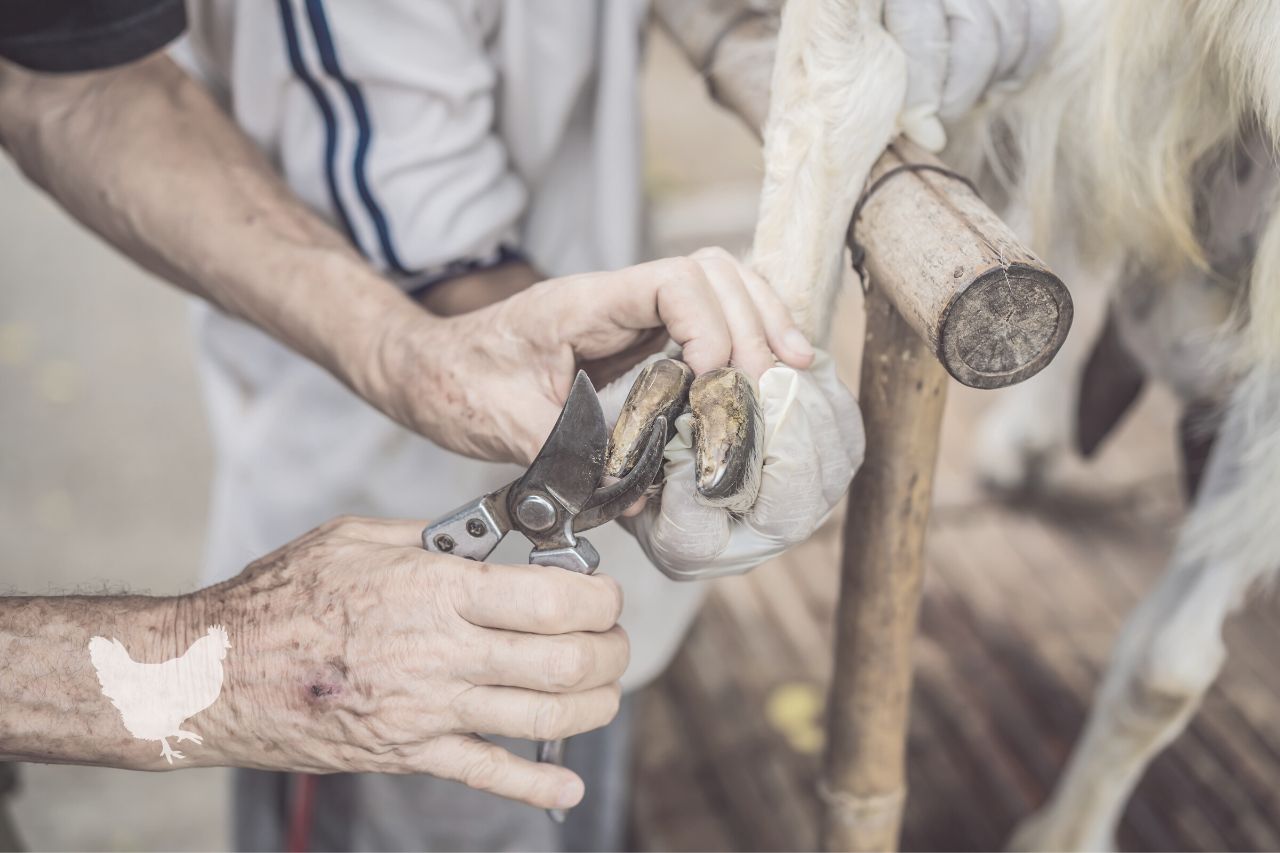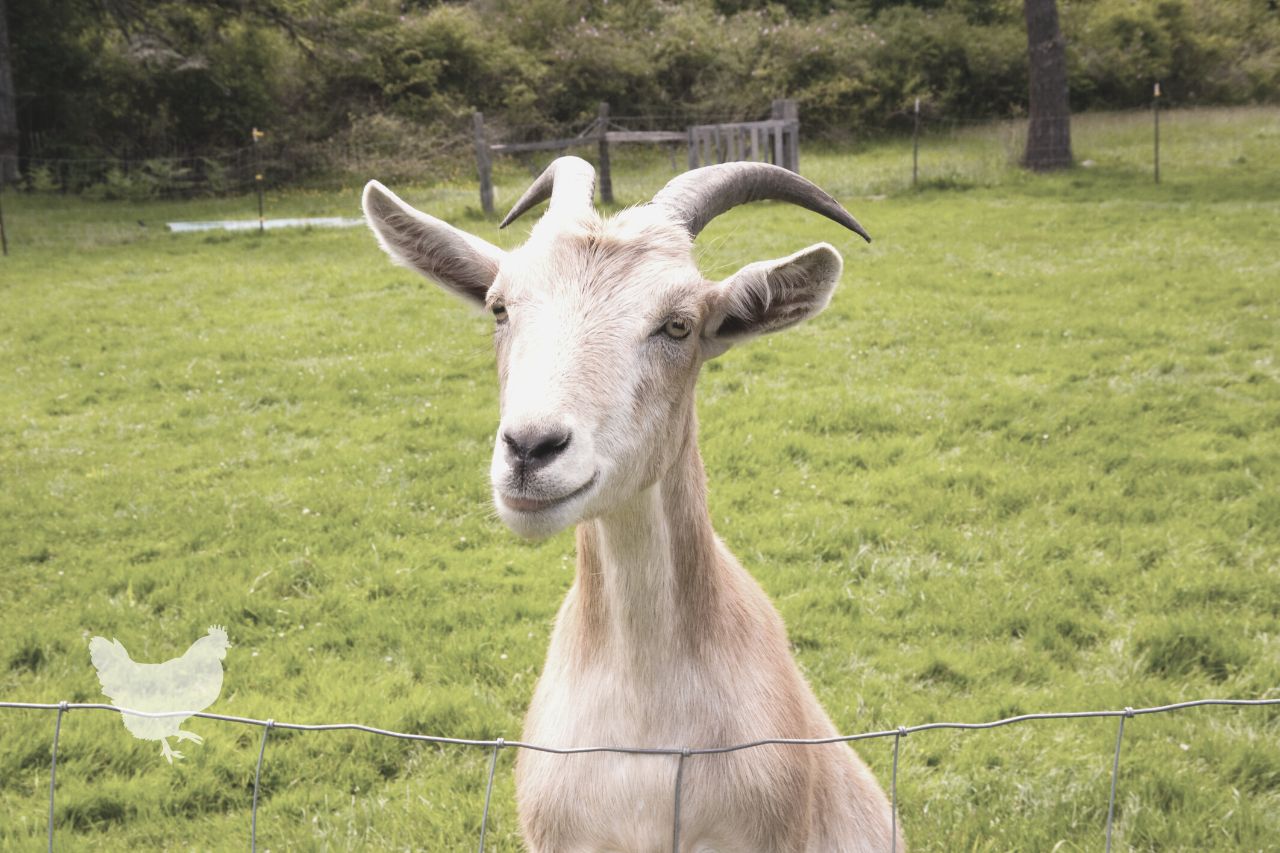When you have goats, it can be difficult to keep up with regular hoof trimming and care, but it’s important to make this chore a priority. Goats’ hooves should be trimmed a minimum of once every ten weeks. Intervals of six-to-eight weeks are preferable.
Overgrown hooves can cause pain, injury and illness. Goats with painful feet tend to move around, eat and browse less. A goat with serious hoof overgrowth may begin crawling about on its knees.
In this article we discuss goat hoof care and provide tips and instructions on proper goat hoof trimming. Read on to learn more.
What You'll Learn Today
5 Steps To Trim A Goat’s Hooves

1. Be sure you have everything you need
Goats are notoriously ornery, so you don’t want to have to stop in the middle of your task to retrieve a needed tool. You’ll need:
- A milking stand or specially made metal trimming stand to hold the animal’s head still and make the hooves easier to access.
- Bucket of feed
- A clean towel to wipe dirt and mud off the hooves
- Freshly sharpened hoof clippers
- A hoof pick
- Cornstarch to staunch blood from accidental nicks and cuts
- Treats to give as rewards for good behavior
2. Evaluate the situation
Once you have the goat secured on the milking stand, happily munching away at feed, and you have all your tools gathered, examine the hooves to see exactly what you’ll need to do.
If hooves are overgrown, you’ll notice that the hardened cartilage of the hoof has folded under the animal’s feet. This means that dirt, mud and manure may have gotten trapped under the folded hoof causing bacterial infection to the soft pads of the sole of the hoof.
You’ll need to work very carefully to avoid injuring this soft tissue, which is likely to be inflamed and tender.
As you examine the goat’s hooves, watch out for:
- Hoof rot
- Soft spots
- Bad smell
- Tenderness
If hoof overgrowth has caused injury or infection, you may need to call in your vet to help you deal with the problem. Extremely overgrown hooves may need to be attended to by a farrier.
3. Clean the hooves
When you have assessed the job before you, you can begin. Always start with a front leg so that you can be near the goat’s head to comfort it and so that the animal can see what you are doing and understand you are not trying to hurt it.
It is typical to start with the left front leg; move to the left hind leg, right hind leg and then finish with the right front leg.
Stroke the goat’s neck, shoulders and back and then run your hand down a front leg to the knee. Gently, but firmly, grasp the lower leg and bend it at the knee so that you can see and work with the hoof.
Use your hoof pick and towel to clean away as much muck and debris as possible from the hoof. Once the first hoof is cleaned, you can either, go all the way around and clean all the hooves and then start trimming, or you can do one hoof at a time completely.
Your choice depends on your preference and the behavior of the animal. Similarly to sheep, some goats are patient with having everything done at once on one hoof. Others like to have the operation performed in increments.
4. Trim carefully
Begin with the front wall of the hoof and end with the heel. The hard material should ideally end up even with the hoof’s sole.
How To Trim Overgrown Goat Hooves
Don’t try to get all of the excess material at once because you run the risk of cutting into the quick and causing pain, injury and potential for infection.
Cut the overgrown hoof off in layers using shallow strokes. When you begin to see pink, you will know you are getting close to the quick, and you should stop.
Your goal is to finish with smooth, even hooves, but if the hooves are very badly overgrown, you may not be able to get all the overgrowth in one trim.
When the hooves grow to excess, the quick can be fairly far down in the hoof material. It may not be possible to trim to an ideal size in one trim without causing potentially serious injury. This is why frequent hoof trimming is so important.
5. Keep an eye on your goat for a few days
Immediately after a trim, it is not unusual for a goat to limp a bit or even lie down and rest for a few hours. If this goes on for more than a day, examine the feet again. You may have cut too close without realizing it, or you may have cut the hooves unevenly.
If you determine a simple fix or adjustment is needed, you can deal with it yourself. If you find serious injury or are unable to figure out what’s wrong, consult your veterinarian.
Additional Tips
- Handle your goats regularly so that hoof trimming is not a strange experience. Daily petting, grooming and lifting of hooves goes a long way toward developing calm, quiet behavior during hoof trimming sessions.
- Talk to the goat calmly throughout the process. Soothe its nerves. Work quickly and confidently, especially on the back feet.
- You may find it easier to trim back hooves while sitting behind the goat rather than beside it.
Keeping Goat Hooves Trim Using Cinder Blocks
Just as you can file your nails down to smooth rough edges between manicures, your goats can file their hooves by walking on rough surfaces or cinder/ concrete/ cement blocks.
Some goat keepers have found that providing walkways and climbing structures made of cinder blocks creates just the right surface to help goats keep their own hooves fairly in trim.
A simple pyramid made of as few as half a dozen cinder blocks can be helpful. Pathways made of cinder brick pavers provide you with good footing in the goat pen and help your goats file their own hooves.
You’ll still need to keep up with a regular trimming schedule, but you may be able to get away with longer intervals between trims using this method.
Frequently Asked Questions

Animals like goats are two-toed ungulates and each of their toes is covered by a separate hoof, resulting in a cloven or split or cleft hoof. Animals like horses, donkeys and zebras are “odd-toed”, meaning that inside each of their single, solid hooves is an uneven number of toes.
If your doe is very heavily pregnant, you should wait until after she delivers to attend to her feet. You should also avoid trimming during extreme weather. If it is very hot, very cold, very dry or very wet, any of these conditions can interfere with the efficiency and effectiveness of your trim.
If you can make a habit of combining hoof care with regular grooming, you will have a far easier time trimming your goat’s hooves. Even though it may seem troublesome, taking the time to brush your goat daily and lift all of its hooves will make trimming very quick and easy when the time comes. For this reason, regular, daily grooming time is the best time to trim your goat’s hooves.
It is very hard to eradicate foot rot, and this condition is very contagious. Avoid having it set in by keeping all new animals in quarantine for a couple of weeks before allowing them to mix with your herd. If you find a case of foot rot early, you may be able to treat it effectively by quarantining the individual goat and providing regular trims and zinc sulfate soaks followed up by copper sulfate spray until the condition subsides. Even so, this may not be successful, and you may need to cull that individual.
The hoof bulb is the thick, spongy part of a goat’s hoof that is located toward the rear of the hoof. This section of the hoof is made up of skin or hide tissue that develops calluses and acts to cushion the sole of the hoof. Goats who live on very rugged terrain tend to have thicker, tougher hoof bulbs than those who live in a barn or paddock setting.
A super hard task, especially when your goat is stubborn.